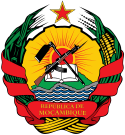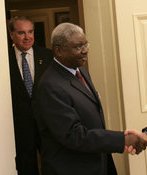سياسة موزمبيق
(تم التحويل من حكومة موزمبيق)
 |
|---|
سياسة موزمبيق، تعمل في إطار جمهوري ديمقراطي تمثيلي شبه رئاسي، حيث رئيس موزمبيق هو رأس الدولة ورئيس الحكومة للدولة ذات التعددية الحزبية.[1][2][3] السلطة التنفيذية ممثلة في الحكومة. بينما السلطة التشريعية تمثلها الحكومة ومجلس الجمهورية. في 2006، صنفت وحدة الاستخبارات الاقتصادية موزمبيق "كنظام هجين".[4]
التاريخ السياسي قبل طرح الديمقراطية
السلطة التنفيذية
| المكتب | الاسم | الحزب | منذ |
|---|---|---|---|
| الرئيس | فيليپي نيوسي | جبهة تحرير موزمبيق | 15 يناير 2015 |
| رئيس الوزراء | كارلس أگوستينو دو روساريو | جبهة تحرير موزمبيق | 17 يناير 2015 |
السلطة التشريعية
مجلس الجمهورية (Assembleia da República) مكون من 250 عضو، يتم انتخابهم لفترة مدتها خمس سنوات بنظام التمثيل النسبي.
الأحزاب السياسية والانتخابات
For other political parties see قائمة الأحزاب السياسية في موزمبيق. An overview on elections and election results is included in الانتخابات في موزمبيق.

رئيس موزمبيق السابق، أرماندو گبوزا.
السلطة القضائية
تتألف السلطة القضائية من المحكمة العليا ومحاكم المقاطعات والبلديات.
التقسيمات الادارية
تنقسم موزمبيق إلى 10 محافظات؛ كابو دلگادو، گازا، إنهامبانه، مانيسا، ماپوتو، نامپولا، نياسا، سوفالا، تـِته، وزامبزيا.
عضوية المنظمات الدولية
انظر أيضاً
المصادر
- ^ Neto, Octávio Amorim; Lobo, Marina Costa (2010). "Between Constitutional Diffusion and Local Politics: Semi-Presidentialism in Portuguese-Speaking Countries". Social Science Research Network. SSRN 1644026.
{{cite journal}}: Cite journal requires|journal=(help) - ^ Shugart, Matthew Søberg (September 2005). "Semi-Presidential Systems: Dual Executive and Mixed Authority Patterns" (PDF). Graduate School of International Relations and Pacific Studies. United States: University of California, San Diego. Archived from the original (PDF) on 19 August 2008. Retrieved 20 August 2016.
{{cite journal}}: Cite has empty unknown parameter:|dead-url=(help) - ^ Shugart, Matthew Søberg (December 2005). "Semi-Presidential Systems: Dual Executive And Mixed Authority Patterns" (PDF). Palgrave Macmillan. Palgrave Macmillan Journals. 3 (3): 323–351. doi:10.1057/palgrave.fp.8200087. Retrieved 20 August 2016.
Of the contemporary cases, only four provide the assembly majority an unrestricted right to vote no confidence, and of these, only two allow the president unrestricted authority to appoint the prime minister. These two, Mozambique and Namibia, as well as the Weimar Republic, thus resemble most closely the structure of authority depicted in the right panel of Figure 3, whereby the dual accountability of the cabinet to both the president and the assembly is maximized.
- ^ solutions, EIU digital. "Democracy Index 2016 - The Economist Intelligence Unit". www.eiu.com (in الإنجليزية). Retrieved 2017-12-01.
قراءات إضافية
- Hanlon, Joseph, and Teresa Smart. Do bicycles equal development in Mozambique?. James Currey Publisher, 2008.
- Manning CL. The politics of peace in Mozambique: post-conflict democratization, 1992-2000. Greenwood Publishing Group; 2002.
- Newitt MD. A history of Mozambique. Indiana University Press; 1995.
وصلات خارجية
- "Considerable change" Decentralisation and public participation in Mozambique.
This article contains content from Wikimedia licensed under CC BY-SA 4.0. Please comply with the license terms.